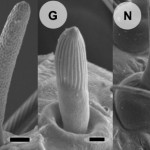
Placing comb jellies, such as these, as the relative to all animals changes our view of how complex features evolved. Image Credit: Tracie Hall, Flickr
A new study published this October in Nature Ecology and Evolution closed a chapter on a decade-long debate in biology and raises questions about how we view the evolution of complex animal traits.
Since 2008, biologists have argued whether sponges or comb jellies, marine jelly-like animals also called ctenophores (pronounced: TEEN-oh-fores), are the earliest relative of all other animals.
It’s a matter of switching one branch for the other on the animal tree of life, but the switch flips our long-held view about how traits like muscles and nerves came about.
“We’ve long assumed that sponges were most likely the earliest split on the animal tree of life because they look simple,” says Nathan Whelan, an evolutionary biologist with the U.S. Fish and Wildlife Services and the lead author on the study.
With only a hollow, porous tube for their body and no nerves, muscles or brain, sponges seem simple compared to other animals, including comb jellies which have all those traits. In traditional theory, that means sponges evolved earlier.
“But that’s an oversimplified and incorrect view of how evolution works,” says Whelan—there’s nothing in evolution that inherently pushes organisms from simple to complex.
That was reaffirmed when a team of 18 scientists in 2008 published a study that for the first time swapped comb jellies for sponges at the base of the animal tree, and it sparked a debate that has lasted now for nearly a decade.
Researchers around the world have built computers models using genetic information from both sponges and comb jellies to sway the argument one way or the other, but Whelan and his team sought to push the envelope in their study.
“The goal was to address some of the criticisms that were made in the past and to have much higher ctenophore sampling than before,” he says. Having more comb jellies means having more genetic information that can be compared to other animals to infer their relations with one another, and that should help remove assumptions made in prior studies.
They collected genes from comb jellies around the world to produce the largest collection of ctenophore genetic data yet. They then used only specific genes shared by comb jellies and all other animals for their comparison, and then removed any genes they found that could produce misleading results.
In the end, they consistently found comb jellies at the base of the tree.
This alone “further erodes the classical, but deeply flawed, perspective that we can arrange living animals from ‘lower organisms…to ‘higher’ and ‘more-evolved’ animals,” wrote Casey Dunn, a biologist at Yale University and who was not part of the study, in a summary article.
However, Davide Pisani, a strong sponge-promoting biologist at the University of Bristol who was also not part of the study, was not convinced by the results. He was struck by how the team’s large collection of comb jelly data was no better at removing assumptions about comb jelly evolution, which would shorten the length of the comb jelly’s branch from the animal tree, than previous studies.
“They add species sampling, but having more species doesn’t necessarily solve the problem,” he says. “You can only solve the problem if you actually break down the branch, but in their case, it doesn’t.”
Regardless, both scientists agree that this study closes a door on the use of protein-coding genes called the transcriptome.
“I think that we have pushed the limits of what we can expect to determine with transcriptome data,” says Whelan
“The next step is to get into different types of genomic data,” says Pisani. “These types of data could provide additional evidence that might give some form of independent evidence.”







Comments are closed.